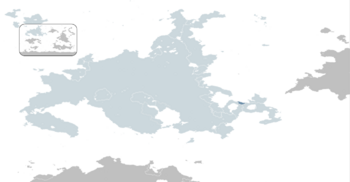Brynmor
Kingdom of Brynmor | |
|---|---|
| Motto: Oherwydd pan fyddwn yn uno, nid ydym yn stopio For when we unite, we do not stop | |
| Anthem: Yma o hyd We are still here. | |
 Brynmor Parthenia | |
| Capital and largest city | Marunath |
| Official languages | Brynnish |
| Recognised regional languages | Charmelcs, Anglish |
| Ethnic groups (2021) | Brynnish 88% Charmelcian 6.3% Anglican 4.1% Vermandois |
| Demonym(s) | Brynnish |
| Government | Unitary parliamentary constitutional monarchy |
• King | Llywelyn III |
| Rhys Griffiths | |
| Legislature | Senedd |
| Assembly of the Siambr | |
| Assembly of Commons | |
| Population | |
• 2022 estimate | 5,156,286 |
• Density | 140/km2 (362.6/sq mi) |
| GDP (PPP) | 2016 estimate |
• Total | $ 238.64 billion |
• Per capita | $ 21,034 |
| HDI (2020) | 0.833 very high |
| Currency | Brynnish Pence (BNP) |
| Internet TLD | .by |
The Kingdom of Brynmor (Brynnish: Teyrnas Brynymôr, Charmelcs: Rioghachd Cnocnamara), commonly known as Brynmor, is a sovereign state in Parthenia. It shares land borders with Angland to the east and Vermand to the west. On it's north coast is the Sea of Slethar. As of 2017, Brynmor's population was approximately 5.3 million. Its capital city is Marunath, which is also the largest city in the country.
Continuous habitation within the modern borders of Brynmor began during the neolithic period as one of the earliest inhabited regions of Parthenia. Early Celtic cultures began to appear in the bronze age and iron age, despite Remillian occupation later on, connecting Brynmor to the other Celtic nations of the Sea of Slethar. Unlike neighbouring Angland, the Remillian occupation had little effect on the culture and people groups of Brynmor, as Celtic culture continued to develop. Following the collapse of the Remillian Empire in 301 AD, Brynmor was split into two kingdoms, Battania and Reyvadoin. It is theorized that these kingdoms would assist eachother in defending their lands from the Livanic invaders from the west, using the hilly terrain to their advantage. In 833 Brynmor was annexed by the Kingdom of Vermand, becoming a state in the north. In 1089, when Angland invaded Vermand, the Anglican monarchy established a monarchy in Brynmor, proclaiming the land "Brya'mordaleat" and becoming a vassal state of the Anglican kingdom used for power over the Vermandois kingdom. In the 16th century, under the Vieri dynasty, Brynmor was fully incorporated into the growing Anglish Empire. Following the death of Arthur I, the Anglican kingdom was left unstable under Anastasia I which Brynmor used to form a united kingdom with Charmelcia, known as the Kingdom of the Two Thrones. This dissolved after both nations established themselves in the 19th century, with a period of Brynnish nationalism during the 1830s.
At the turn of the industrial revolution, Brynmor was one of the first to develop into an industrial nation. Brynmor was known for it's mining, metallurgy and later on car manufacturing which centered itself around the captial city of Marunath. This transformed Brynmor from a country with a focused agriculture industry to an industrial society that was particularly present in it's north-west. Two-thirds of Brynmor's population lives in the north-west and surrounding valleys, with south Brynmor being agricultural while the remainder of the land is sparsely populated. In the late 20th and early 21st century, Brynmor has largely deindustrialised and the industrial industry has been on a heavy decline since the 1960s. Modern Brynmor has it's focus on the public sector, relying on tourism for much of it's economic wealth. Agriculture in Brynmor, due to it's hilly terrain, is mostly livestock based, having an estimated 10.3 million sheep which is higher than the population of human inhabitants.
The country has a distinct, traditional national and cultural identity. They keep positive relations with a majority of democratic nations, and are a member of a number of international organisations such as the United Nations, the Parthenian Community (PC) and the Parthenian Economic Community (PEC).
Etymology
History
Prehistory
Geography
Biodiversity
Climate
Politics and Government
Foreign Relations
Military
Administrative Divisions
Law
Law Enforcement
Economy
Primary sector
Secondary sector
Tertiary sector
Quarternary sector
Energy
Natural resources
Demographics
Urbanization
Immigration
Religion
Languages
Education
Healthcare
Culture
See Also
References
This article is incomplete because it is pending further input from participants, or it is a work-in-progress by one author. Please comment on this article's talk page to share your input, comments and questions. Note: To contribute to this article, you may need to seek help from the author(s) of this page. |
Currently a rump page to help set up overall templates that work on categories. Please do not delete, will be reworked



